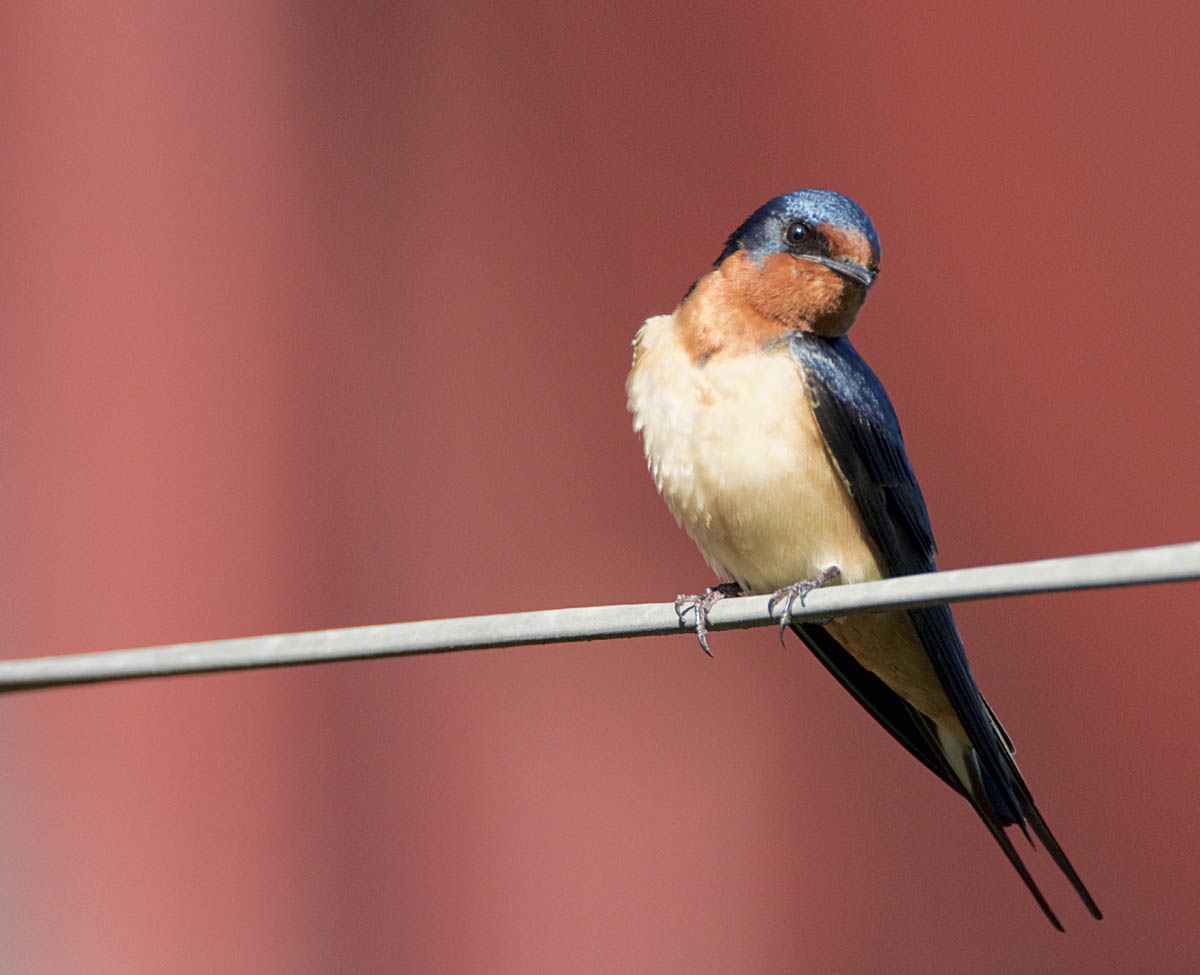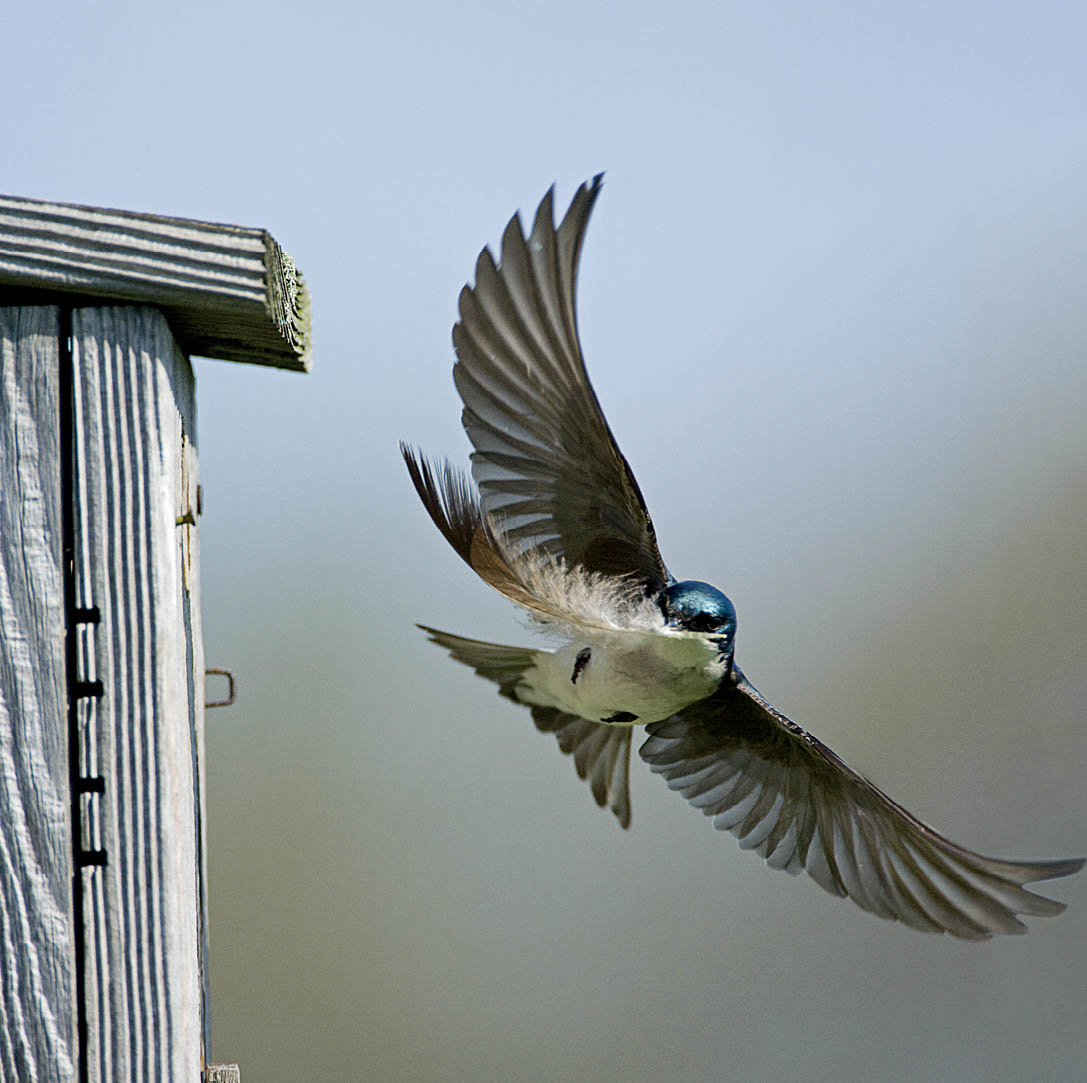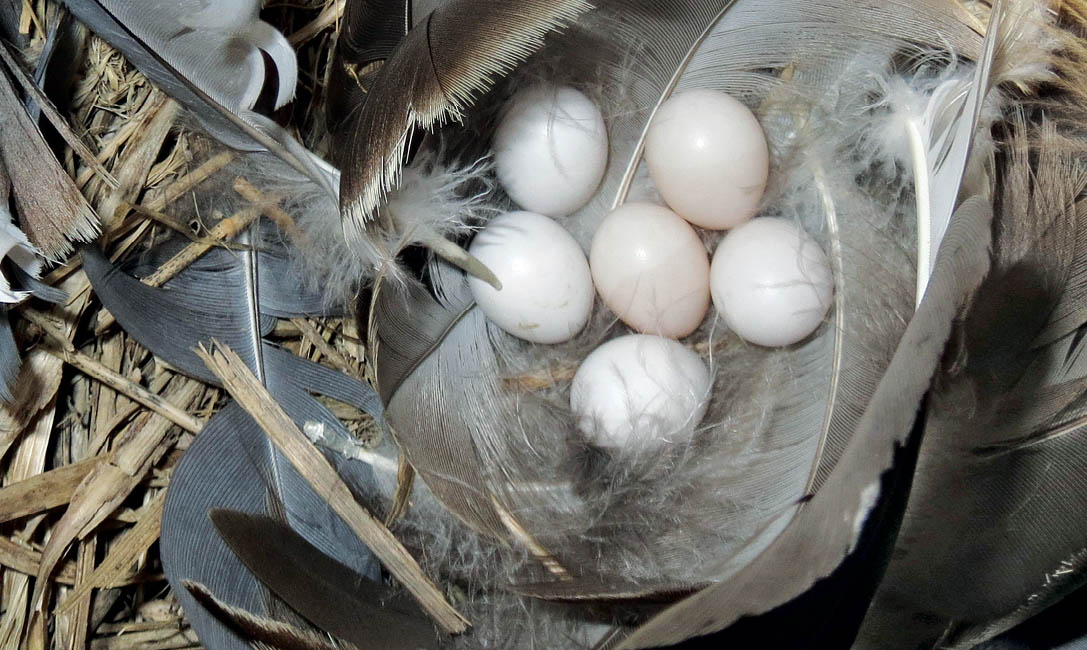
Barn Swallow adult
“One swallow does not a summer make.” That line, coined by Aristotle about 350bce, describes the Barn Swallow, one of the most widespread bird species in the world, native to five continents. Barn Swallows that breed in North America migrate to Central and South America for the winter. Tree Swallows, in contrast, are strictly North American, and don’t migrate nearly as far.

Barn Swallow adult
Tree and Barn Swallows often nest in large, loose groups, but each pair maintains a small territory around the nest.
Tree Swallows travel in huge flocks, sometimes numbering in the hundreds of thousands, that may swirl around like tornadoes. They return to northern states earlier than most swallows and can survive colder temperatures because they’re able to digest berries when flying insects aren’t available. During severe weather and during migration, they may roost communally in cavities, sharing body heat.
In early spring, male Tree Swallows arrive, followed shortly by the females. They find and defend breeding territories in wetlands and fields, preferring areas near water over which they forage for flying insects. Severe cold snaps can kill many, especially after nesting begins, when the birds are more reluctant to roost communally. Fortunately, Tree Swallow numbers are fairly robust, so their populations survive these setbacks.

A territorial Tree Swallow chases a challenger from a perch near a nest box. Competition over nest sites can be intense.

A courting male Tree Swallow perches near his nest site, pointing his bill upward and flicking his wings at an approaching female. If interested, she joins him, and together they may investigate the nest hole.
Courtship and territoriality are noisy, with constant chattering calls as both male and female chase and squabble with neighboring pairs. They nest in abandoned woodpecker holes, crevices in dead trees, and nest boxes. Male Tree Swallows battle vigorously to defend nest sites, pecking at one another’s head and back in midair, on the ground, inside the cavity, or atop the nest box. Occasionally one combatant dies, especially if it cannot escape within a cavity or if it drowns when they’re tussling over water. Females chase and may fight each other, but less often and less violently than males. Fights in both sexes are much more frequent in areas where the birds outnumber potential nest sites.
When a female Tree Swallow accepts a male’s cavity, she starts collecting nesting material on the ground and takes charge of nest construction. The nest is made of grass, pine needles, mosses, rootlets, animal hair, and sometimes human-made items such as cellophane and cigarette filters. The female presses her body into the nest material, shuffling around to form a cup-shaped depression.

A Tree Swallow carries a feather to use as nest lining in a nest box. Feathers are valuable commodities, often causing chases and midair battles as swallows try to steal them from each other.

Tree Swallows copulate near their nest site. The male hovers above the female, giving distinctive ticking calls as she crouches and raises her tail. He lands on her back, fluttering his wings and grasping her head feathers for balance; he then maneuvers his tail sideways and under hers to make cloacal contact.
Once the basic nest is constructed, the pair, especially the male, may wander far and wide looking for feathers with which to line the nest. When prairie-chickens disperse after performing their dances on spring mornings, Tree Swallows swoop in to snatch feathers the chickens lost in clashes with competitors. Gull colonies and poultry farms provide feathers, too, and duck feathers are plucked from the surface of ponds and lakes or in midair, floating on the breeze.
The more feathers in a nest, the shorter the incubation and nestling periods, the larger the nestlings, and the better chance of fledging. The feathers may provide insulation or a barrier to parasites; research is inconclusive.

Six white Tree Swallow eggs, snug in their feather-lined bed. The parents arrange the feathers with quills pointed under the nest cup, the vanes curling up to cover the eggs.
Arriving later in spring than Tree Swallows, Barn Swallows pair off within two weeks of arrival. They prefer to mate with the available Barn Swallow with the longest, most symmetrical tail.
Once cave nesters, Barn Swallows now gravitate to human structures, nesting under bridges, in culverts, in barns, on the eaves of houses, and in other protected places, but seldom in small cavities. Not nearly as territorial or combative as Tree Swallows, Barn Swallows often nest within a few feet, or even inches, of their neighbors. In one study, about half of all nests included some chicks fathered by a male other than the one raising them.
Both male and female Barn Swallows collect mouth-sized mud pellets to build their nests. Large groups congregate at mud puddles and muddy shorelines to collect the pellets, which they may mix with grasses or other fibers. They carry these pellets to the nest site, a vertical wall preferably above a sturdy support.
After constructing a mud shelf large enough to sit on, the male and female build up the sides. The female shapes the cup. They finish the basic nest in four to eighteen days (depending on weather and the availability of mud), line it with grass, and finish it with feathers. They recognize their own nest in a colony by both its position and visual features. When a pair of Barn Swallows is away from the nest, others in the colony may steal lining materials.

Barn Swallows rarely come to the ground except when nest-building. They gather beakfuls of mud, often including a little wet grass, from the edges of puddles, ponds, and lakes. They carry these mud pellets to the nest site to build up a cup-shaped outer nest that they line with grass.
Tree Swallows are considered monogamous, but only in the way that soap opera characters are. Of all songbirds studied using DNA fingerprinting, Tree Swallows have the highest rate of extra-pair paternity. Studies show that in at least some populations, over 90 percent of nests contain one or more chicks not related to the male caring for the brood, and over 50 percent of nests contain chicks fathered by still another male or two. Paternity notwithstanding, the pair works together to raise one brood a year, sometimes two in the more southern and western reaches of their range.
Usually, only female Tree Swallows incubate, though males help in some western populations and during severe weather in the East. They incubate for 11 to 20 days, varying with weather conditions. Male Barn Swallows often incubate, though only the females bear a brood patch. Barn Swallow eggs hatch after about 13 days, with extremes at 12 to 17 days.
As nestlings beg for food, their eyes still sealed shut, the comparative sizes of their open mouths seem to show the parent which is hungriest. As soon as a nestling consumes a morsel, it hunkers down and poops, giving the others a chance for a meal. In both species, the parents carry off fecal sacs for the first 10 to 15 days; then they lose interest and droppings collect. By this time, Barn Swallow young back off the nest to poop (this is when many people lose patience with the swallows nesting on their front porch). The droppings accumulate in a mess inside Tree Swallow cavities and nest boxes.
Swallows forage on the wing for flying insects, including flies, dragonflies, damselflies, mayflies, butterflies, and moths. Finding enough for themselves and their young in wet, cold, or windy weather, when insects do not fly, can be challenging.

A male Tree Swallow peers from the nest cavity entrance, acting as sentinel until his mate returns. The female alternates incubating in bouts of up to 15 minutes with short flights off the nest, waiting to hear the male’s chirp nearby before she departs to feed. He doesn’t bring her food.

Two tiny Tree Swallow hatchlings lie helplessly on their feathery bed beside their unhatched siblings.

A Tree Swallow clings to its nest cavity, holding a beakful of insects for its young. The bird’s mate arrived first; its tail feathers are visible in the cavity.
The young of both species fledge when 15 to 25 days old and are strong fliers from the start. Barn Swallow young return to the nest to roost for a few nights; Tree Swallow young seldom return. As they grow independent, they join flocks of swallows.
Both species often reuse their nest for a second brood and in subsequent years. Barn Swallows add new mud and replace the lining. Tree Swallows build a new nest above the old one.
Many people clean out Tree Swallow boxes. When birds reuse nest boxes that have not been cleaned, the nestlings are subjected to a higher load of parasites, but nests in these boxes seem to succeed as well as those that are cleaned every year.